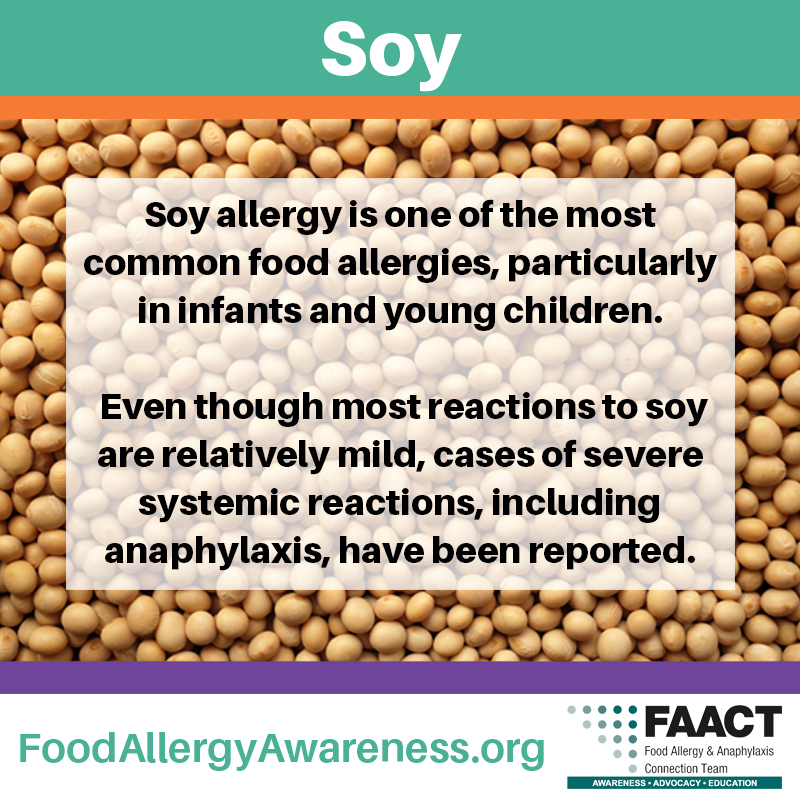Soy
Subcategories

Soy
Soy allergy is one of the most common food allergies, particularly in infants and young children. Although it occurs in roughly 0.5% of children, soy allergy is typically outgrown by school age years and almost always by adolescence. Even though most reactions to soy are relatively mild, cases of severe systemic reactions, including anaphylaxis, have been reported. It is therefore imperative that individuals with soy allergy carefully read labels and carry epinephrine at all times.
- When considering food avoidance and reading labels, it is important to know that although soy is a member of the legume family, there is no increased risk of reactions to other legumes, such as beans, peas, lentils, and even peanuts.
- Soy-allergic individuals can also generally tolerate soybean oil and soy lecithin without difficulty, since these products carry little to no allergenic protein.
- Beyond the classical IgE-mediated allergic reactions that pose a risk of anaphylaxis, soy can also cause a variety of symptoms through additional mechanisms.
- Examples include soy intolerance, or triggers for conditions such as eosinophilic esophagitis (EoE) and food protein-induced proctocolitis (FPIES). A thorough evaluation with a board-certified allergist can help elucidate the specific type of reaction to soy and subsequent recommendations.
Practical Tips
It is recommended to always carry at least two (2) epinephrine devices at all times if you have been diagnosed with a food allergy, including soy allergy. This is in case one misfires or if symptoms recur and a second dose is needed. If an epinephrine device has been used, always seek emergency medical assistance immediately. This is due to the possibility of a biphasic reaction. A biphasic reaction is when a second wave of symptoms occurs. This typically happens from 2-6 hours following the initial reaction.
Read all product labels prior to the consumption of a new food product. Before consuming any products, it is important to always read labels carefully to ensure the safety of food products. All food products that contain soy protein as an ingredient are required by FALCPA law to list the word “Soy” on the product label. Please note, manufacturing practices may change without notice. According to the Food Allergen Labeling and Consumer Protection Act (FALCPA), food products with advisory statements such as “may contain,” “processed in the same plant,” or “manufactured on the same line” on a package are completely voluntary, and can be ambiguous. The true level of contamination is not declared, and may range from parts per million to micrograms. There may be different risks associated with these levels; it is generally recommended to avoid products with such labeling because of this uncertainty, but you should discuss with your allergist which particular labels should be avoided.
Visiting restaurants can be a pleasant experience for family and friends to gather together. However, some restaurants may pose as a risk. Some restaurants are considered high risk for individuals with a soy allergy due to the common use of soy as an ingredient, as well as the associated risk of cross-contaminated cooking surfaces and utensils. Please review our 'Dining Out' page for tips on how to manage visiting a restaurant. Be vigilant, ask questions, and if there is any doubt, don’t eat the food item in question.
AVOID foods that contain soy ingredients, such as:
- Soybean
- Soy protein
- Soy sauce
- Soya
- Edamame
- Miso
- Natto
- Shoyu
- Tofu
- Tamari
- Tempeh
Foods that may contain soy as a hidden or unexpected ingredient:
- Baked goods
- Canned meats, including canned tuna
- Processed meats
- High protein energy bars
- Infant formulas
NOTE: Please keep in mind in a culturally diverse world, different ingredients may be used in different recipes. Always use extreme caution.
Other pages that may be of interest:
Visit FAACT's CROSS-CONTACT page to review how to properly clean allergens from hands and surfaces.

